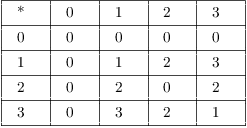How to Find Solutions to Linear Congruences
Linear Congruences
Theorem. Let ![]() , and consider the equation
, and consider the equation
![]()
(a) If ![]() , there are no solutions.
, there are no solutions.
(b) If ![]() , there are exactly d distinct solutions mod m.
, there are exactly d distinct solutions mod m.
Proof. Observe that
![]()
Hence, (a) follows immediately from the corresponding result on linear Diophantine equations. The result on linear Diophantine equations which corresponds to (b) says that if ![]() is a particular solution, then there are infinitely many integer solutions
is a particular solution, then there are infinitely many integer solutions
![]()
I need to show that of these infinitely many solutions, there are exactly d distinct solutions mod m.
Suppose two solutions of this form are congruent mod m:
![]()
Then
![]()
Now ![]() divides both sides, and
divides both sides, and ![]() , so I can divide this congruence through by
, so I can divide this congruence through by ![]() to obtain
to obtain
![]()
Going the other way, suppose ![]() . This means that
. This means that ![]() and
and ![]() differ by a multiple of d:
differ by a multiple of d:
![]()
So
![]()
This implies that
![]()
So
![]()
Let me summarize what I've just shown. I've proven that two solutions of the above form are equal mod m if and only if their parameter values are equal mod d. That is, if I let t range over a complete system of residues mod d, then ![]() ranges over all possible solutions mod m. To be very specific, all the solutions mod m are given by
ranges over all possible solutions mod m. To be very specific, all the solutions mod m are given by
![]()
Example. Solve ![]() .
.
Since ![]() , there are no solutions.
, there are no solutions.![]()
Example. Solve ![]() .
.
Since ![]() , there will be 1 solutions mod 4. I'll find it in three different ways.
, there will be 1 solutions mod 4. I'll find it in three different ways.
Using linear Diophantine equations.
![]()
By inspection ![]() ,
, ![]() is a particular solution.
is a particular solution. ![]() , so the general solution is
, so the general solution is
![]()
The y equation is irrelevant. The x equation says
![]()
Using the Euclidean algorithm. Since ![]() , some linear combination of 3 and 4 is equal to 1. In fact,
, some linear combination of 3 and 4 is equal to 1. In fact,
![]()
This tells me how to juggle the coefficient of x to get ![]() :
:

(I used the fact that ![]() .
.
Using inverses mod 4. Here is a multiplication table mod 4:

I see that ![]() , so I multiply the equation by 3:
, so I multiply the equation by 3:
![]()
Theorem. Let ![]() , and consider the equation
, and consider the equation
![]()
(a) If ![]() , there are no solutions.
, there are no solutions.
(b) If ![]() , there are exactly
, there are exactly ![]() distinct solutions mod m.
distinct solutions mod m.
I won't give the proof; it follows from the corresponding result on linear Diophantine equations.
Example. Solve
![]()
![]() , so there are
, so there are ![]() solutions mod 10. I'll solve the equation using a reduction trick similar to the one I used to solve two variable linear Diophantine equations.
solutions mod 10. I'll solve the equation using a reduction trick similar to the one I used to solve two variable linear Diophantine equations.
The given equation is equivalent to
![]()
Set
![]()
Then
![]()
![]() ,
, ![]() , is a particular solution. The general solution is
, is a particular solution. The general solution is
![]()
Substitute for w:
![]()
![]() ,
, ![]() , is a particular solution. The general solution is
, is a particular solution. The general solution is
![]()
![]() will produce distinct values of y mod 10. Note, however, that s and
will produce distinct values of y mod 10. Note, however, that s and ![]() produce
produce ![]() and
and ![]() , which are congruent mod 10. That is, adding a multiple of 2 to a given value of s makes the
, which are congruent mod 10. That is, adding a multiple of 2 to a given value of s makes the ![]() term in x repeat itself mod 10. So I can get all possibilities for x mod 10 by letting
term in x repeat itself mod 10. So I can get all possibilities for x mod 10 by letting ![]() .
.
All together, the distinct solutions mod 10 are
![]()
Remarks: I saw the particular solution ![]() ,
, ![]() by inspection. In general, you can get one using the Extended Euclidean algorithm. For example, in this case
by inspection. In general, you can get one using the Extended Euclidean algorithm. For example, in this case
![]()
Multiply by ![]() (to match
(to match ![]() ) to get
) to get
![]()
So a particular solution is ![]() and
and ![]() .
.
In general, it can be tricky to determine the parameter ranges which give the correct number of solutions; it may require some trial-and-error, or careful analysis of the general solution.
Contact information
Bruce Ikenaga's Home Page
Copyright 2019 by Bruce Ikenaga
How to Find Solutions to Linear Congruences
Source: https://sites.millersville.edu/bikenaga/number-theory/linear-congruences/linear-congruences.html

0 Response to "How to Find Solutions to Linear Congruences"
Post a Comment